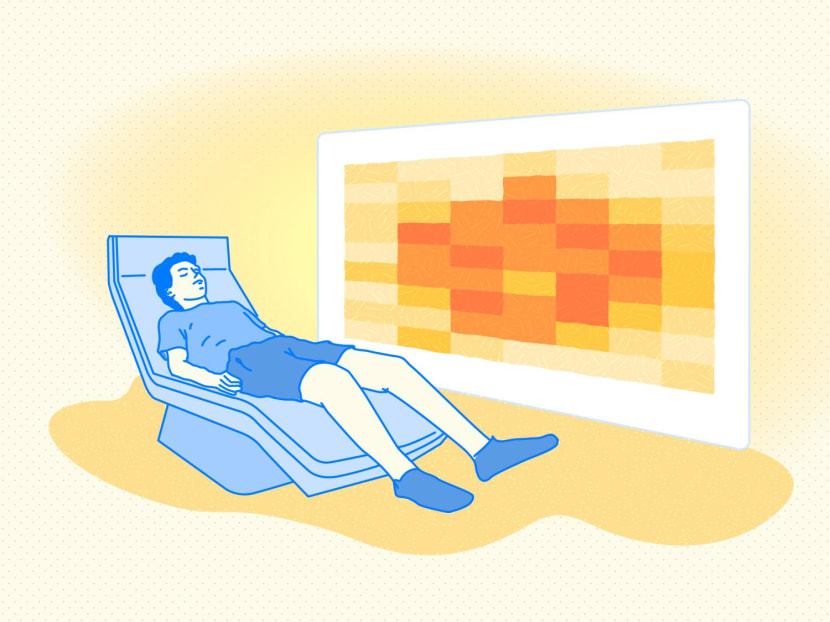Gen Zen: Are salt rooms really worth their salt? I tried one to see if they can really help me de-stress

(Illustration: CNA/Samuel Woo)
SINGAPORE — I’m laid back on a leather chaise after an hour-long workout, staring at a heated tray of rocks from the Himalayas.
The walls are amber, the room is warm, but more importantly, the air is salty.
Several beauty and wellness outlets around Singapore have over the years built their very own “salt rooms” — spaces filled top to bottom with sodium chloride — in which they offer a range of services such as facial spas and even yoga.
This quiet cave-like environment that I’m in is one of them.
Its walls are lined with orange-hued panels of crystalline salt and is coined a “Himalayan Salt Inhalation Room” — a wellness rest pit by fitness chain Virgin Active that can be found in three of its outlets across the country.
I am here because I had read online that breathing in tiny salt particles in the air — a practice known as halotherapy — can potentially improve one’s lung function, provide relief from skin conditions such as eczema, and even help people with their depression and anxiety.
I certainly don’t mind mucus-free airways and better skin. However, what I’m most interested in is the mental health benefits that inhaling salt purportedly provides.
Can it really help us de-stress, or get us out of a psychological pickle?
Current research indicates that it’s unlikely, but surely it’s worth trying out myself to find out if salt rooms are truly worth their salt.
CAN SALT ROOMS IMPROVE YOUR MENTAL WELL-BEING?
The roots of halotherapy can be traced back to Eastern European salt mines in the 19th century, when a Polish physician named Feliks Boczkowski noticed that salt miners had better respiratory health and clearer skin.
This eventually sparked the idea of using salt for a wide variety of therapeutic purposes, including mental health conditions.
I didn’t quite enter a salt mine myself, but I did spend around 30 minutes in Virgin Active’s salt rooms on three separate occasions and tried to document my experience.
The brand's Southeast Asia country director Julien Bera said that these rooms have been well-received and utilised by its Singaporean club members over the years.
Truth be told, there wasn’t much to document because all that was required of me was to breathe, but I did feel a sense of calm each time I kicked back on the daybeds and inhaled the rooms’ “salty” air — especially after a long day at work.
I often found the people next to me in the room with their eyes closed as well, and I was tempted to join them in deep slumber.
Ms Sabrina Hung, a 24-year-old banking analyst who visits the salt room at the fitness chain’s Raffles Place outlet around three times a week, said: “I definitely feel more relaxed and wound down.
"The ambience and temperature, with the warm lighting and the salt pit, reminds me of a campfire.
“I’m not sure about the science behind it, but it’s the perfect place to take a good nap.”
Similarly, public relations consultant Jayce Seah, 27, said that she often feels relaxed in the salt room, even if she does not “immediately find a direct physical benefit”.
The oft-quoted assertion found on websites promoting salt therapy is that salt air releases negative ions, which can affect a person’s mood positively if they are exposed to them in sufficient amounts.
So far, it seems as though the de-stressing factor holds up, at least anecdotally, but are these claims backed scientifically? Well, somewhat.
In a 2023 literature review published in the Environmental Science and Pollution Research journal, its authors pointed to inconsistent findings on whether air ions have an effect on mental well-being, based on studies of anxiety, mood, relaxation or sleep, and personal comfort.
However, their meta-analysis of five different studies showed that exposure to a high concentration of negative air ions was indeed significantly correlated with lower depression scores.
Even then, the researchers said that the findings should be “cautiously interpreted”, because the body of work analysed either did not control for, or failed to report on, environmental factors such as air flow, humidity and temperature.
Dr Joel Yang, a clinical psychologist at psychological consultancy firm Mind What Matters, agreed with that assessment, stating that research on the subject is still “rather limited”.
In order to establish a stronger link between halotherapy and mental health, Dr Yang said that future studies should have participants use such therapy on a regular basis over an extended period of time, while continually rating their mood and reporting the effects that the practice has on them.
IS IT ALL JUST IN THE MIND?
Dr Yang also said that existing research does not necessarily rule out placebo effects either.
“The placebo effect is where one strongly believes that it does have a positive effect on their mental health, and that in and of itself could lead to feeling better emotionally,” he added.
While Ms Hung had not heard about the purported benefits that salt rooms provide, Ms Seah and I had. Could my relaxed state inside the salt rooms be due to the expectation that I would feel that way?
Maybe, although there’s no real way of telling.
For the same reason that much existing research on halotherapy is inconclusive, it is also hard to know whether the calmness that Ms Hung, Ms Seah and myself experienced is due to the “salt” factor of the salt rooms — considering the myriad of other factors present in the environment.
These factors include the muted atmosphere, the sauna-like temperature and the soothing colour of sandstone, for instance.
Being in a physical space where others are visibly relaxed may have also primed me to feel the same way.
For Ms Seah, who started going to salt rooms in January this year, the perks that come with inhaling salt are secondary to the overall experience.
What matters to her is “having a convenient space that I can enjoy taking a break in the midst of a busy day”.
“If it makes me feel good at the moment, that’s wellness to me,” she said.
“If I can also reap the benefits in the long term, then that’s a plus.”
For now, it might be worth taking with a pinch of salt halotherapy’s claims that it can heal mental health problems, but perhaps, what’s worth considering is the benefit of having a dedicated space to unwind.
To deliberately set aside a time and place to let go of the day’s worries — whether or not we’re staring at a row of Himalayan salt rocks — might do us a world of good.








